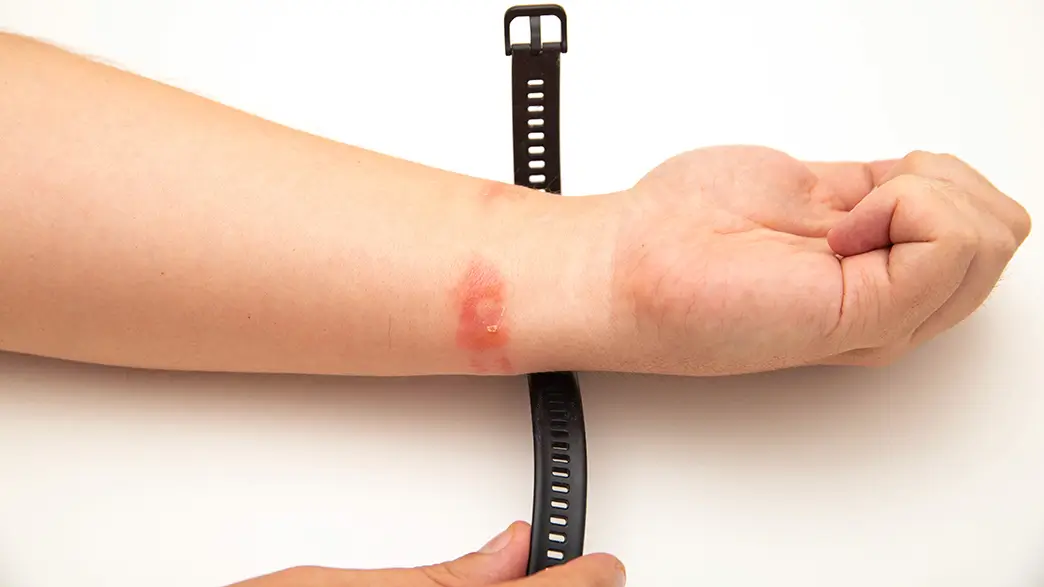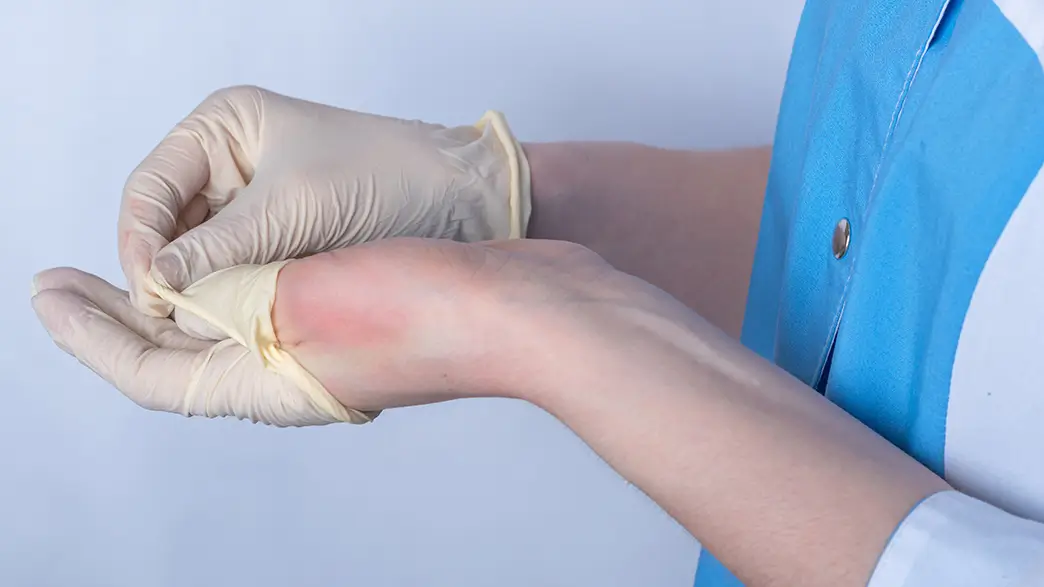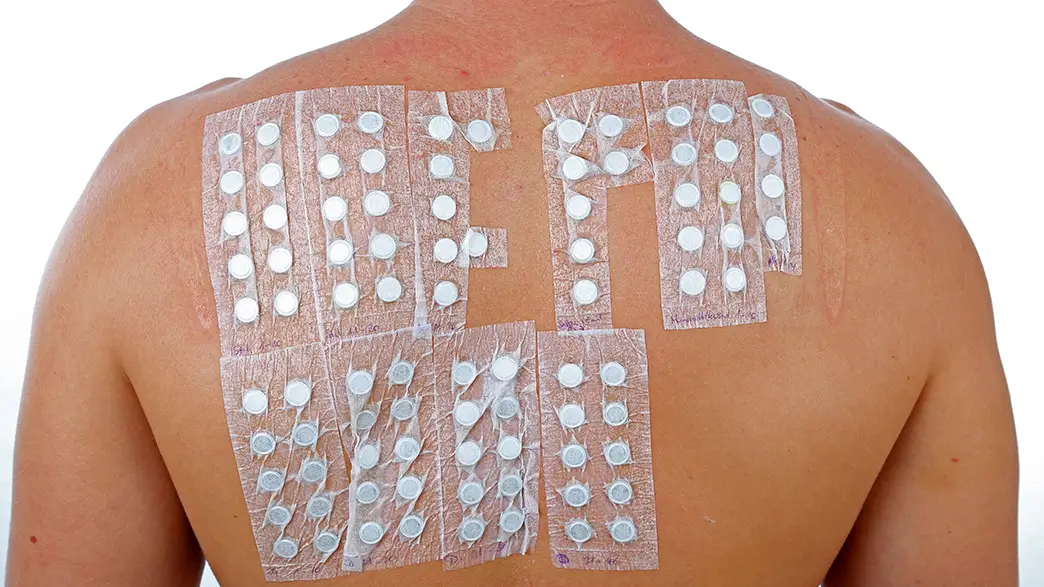
Contact Allergy – Nickel, Latex & Co Beware, Don’t Touch!
Contact allergies are triggered by various substances or materials that come into direct contact with the skin. You have probably heard of a nickel allergy or a latex allergy – nickel and latex are among the most well-known triggers of contact allergies. However, they are by no means the only substances that affect people. The symptoms of a contact allergy can manifest as severe itching, rashes, or even the formation of so-called contact eczema. The tricky part: it can take days from exposure to the allergen until the allergic reaction occurs, making this allergy particularly insidious.
In the table of contents of this article, you can see the different subtopics on contact allergies. Simply click on the heading to jump to the desired section.

What happens in a contact allergy?
A contact allergy can develop when the immune system becomes sensitized to a certain substance, even though it is completely harmless. In the case of a nickel allergy, for example, sensitization occurs through direct contact between a nickel-containing trouser button and the skin. When the skin touches the button, tiny, microscopic nickel particles are released. If an allergy exists, the immune system reacts by producing T-lymphocytes. These are helper cells that attack the perceived threat and cause inflammation. Special T-memory cells ensure that once the intruder is recognized, it is fought off faster in future encounters.
Contact allergies never manifest at the first contact with the allergen. When triggered upon subsequent contact, symptoms often appear only after 12 hours or even after three days. This is a type IV allergy, known as a delayed-type hypersensitivity. This delayed immune reaction makes it difficult to identify the cause of the allergy. The reason for the delayed response is the long journey of the T-helper cells from the lower to the upper skin layers.
Typical symptoms of a contact allergy include redness and swelling of the affected area, accompanied by itching or a burning sensation. In addition, hives or oozing blisters can form at the contact site. In severe cases, itchy crusts and scales may develop, resembling psoriasis. The longer the allergen remains in contact, the more severe the allergic reactions can become. Continued exposure poses a real risk of developing chronic contact eczema with thickened, cracked skin. Occasionally, delayed symptoms may appear in other parts of the body, even if they were not in contact with the allergen. This is a spreading reaction of the contact allergy.
Additional Health Risks of Chronic Contact Eczema
Any injury to the skin surface provides an entry point for germs. Itchy blisters or hives should therefore not be scratched open. Chronic contact eczema is particularly dangerous, as cracks and fissures in the skin can harbor fungi or bacteria. A feeling of warmth, swelling, severe redness, and pain at the affected site indicate an ensuing infection. This may require further treatment with antibiotics or antifungal medication. For people with weakened immune systems, it is especially important to identify contact allergies and avoid their triggers.

What are common triggers of contact allergies?
Various substances are known to trigger contact allergies. These include metals like nickel, natural latex rubber, fragrances, preservatives, or plasticizers found in cleaning agents. Even plant-based products like essential oils or different plants themselves can cause sensitization upon skin contact. Factors such as pollution, smoking, poor nutrition, or genetic predispositions are believed to increase the likelihood of developing a contact allergy. The most common contact allergies are nickel and latex allergies.
Nickel Allergy – Allergic to a Metal
The nickel allergy is the most common contact allergy. Nickel, a transition metal, is an important industrial material used in the production of stainless steel and various alloys. It is commonly found in coins, trouser buttons, belt buckles, and costume jewelry. Many everyday objects that come into contact with human skin contain nickel. European studies show that contact with the allergen nickel can lead to sensitization in up to 10–25 percent of the population. However, this does not mean that all sensitized individuals develop symptoms. Approximately 8–10 percent of adults in Germany suffer from an active nickel allergy, with women being affected up to four times more often than men.
When a nickel allergy flares up, it manifests as nickel dermatitis, with symptoms ranging from scaling skin, papules, blisters, itching, redness, and pain to the development of an allergic contact eczema. If the allergy is not recognized and contact with nickel is not stopped, the affected skin area can thicken chronically. There is also a risk of further complications from scratching blisters and eczema, leading to infections. In smaller amounts, nickel can also be absorbed through food – for example, potatoes contain some nickel. In rare cases, existing symptoms may be worsened by nickel in the diet.
In case of an allergy, contact with nickel should be strictly avoided. Make sure nickel-containing items do not come into direct contact with bare skin. Protective gloves can be worn to safeguard the hands. Nickel jewelry should be avoided – there are alternative materials that are allergen-free. Since 1994, the EU has set guidelines on the permissible nickel content in items that come into prolonged contact with the skin. Complaints caused by inhaling nickel particles are recognized as occupational diseases and can occur in industrial environments, such as nickel processing. In everyday life, nickel exposure in the air is very low.

Latex Allergy – in Two Variants
Natural latex is made from the sap of the rubber tree. The material is used in the production of medical protective gloves, condoms, or carnival masks. Rubber trees are also popular houseplants, but some people develop a latex allergy to the sap and products made from it. Frequently, substances like thiurams or dithiocarbamates, which form during the industrial production of latex gloves and other products, are responsible for the allergic reaction.
Unlike most contact allergies, the latex allergy can occur as both a delayed-type and an immediate-type allergy. In some cases, the allergy is triggered by proteins in latex, causing an immediate reaction within minutes of skin contact. Urticaria is a typical symptom and presents as itchy hives on the affected skin areas. The respiratory system may also be affected in cases of "immediate-type latex allergy," causing symptoms like a runny nose, coughing, or even shortness of breath. A delayed reaction occurs when chemicals like thiurams are the triggers. As a delayed-type allergy of class IV, the latex allergy presents after several hours or days with the development of contact eczema. In rare cases, a latex allergy can lead to an anaphylactic shock.
Since the 1990s, various laws have been enacted to reduce the incidence of latex allergies. For example, the use of powdered latex gloves has been banned. The powder, mixed with latex particles, could be absorbed through the skin and respiratory tract. Today, there are many alternative materials that do not cause allergies – such as synthetic rubber. In the medical field or in caregiving, where protective gloves are indispensable, latex gloves can be replaced by gloves made from nitrile, vitril, vinyl, or cotton. Be sure to buy gloves labeled as thiuram-free and/or dithiocarbamate-free, as these substances can also be found in other materials besides latex.
- Nitrile gloves: Nitrile gloves are a good alternative to latex gloves, offering excellent tactile sensitivity, flexibility, and tear resistance. They are also resistant to many chemicals, oils, and fats. Nitrile gloves are used in medical settings, laboratories, and by cleaning and caregiving services. They are also suitable for handling food.
- Vinyl gloves: Vinyl is a soft, comfortable material with a very smooth surface. Vinyl gloves are available in powdered form, making them easier to put on and take off and helping to reduce sweating.
- Vitrile gloves: These are hybrid gloves made from a combination of vinyl and nitrile, combining the advantages of both materials without compromising on quality.
- Cotton gloves: Cotton is a material that does not cause contact allergies. However, allergies to chemicals or other substances in cotton products can still exist. Pure cotton gloves are therefore used in medical settings. Due to their soft and pleasant texture, they are suitable as examination gloves or as a gentle underlay for other gloves. Cotton gloves can usually be washed or sterilized in an autoclave with hot steam and reused.
The latex-fruit syndrome is a cross-allergy that affects more than one-third of latex allergy sufferers. Those affected show allergic reactions after consuming fruit. However, some vegetables like tomatoes or bell peppers, as well as nuts, potatoes, or buckwheat, can also trigger cross-allergies with latex.

How is a contact allergy diagnosed and treated?
In some cases, it is easy to determine that a contact allergy is causing symptoms such as rashes, blisters, or eczema. Although the symptoms develop slowly, it is clear that the affected area, such as the wrist where costume jewelry was worn, is the culprit. It is more challenging if you do not know what material you came into contact with in the 12–72 hours before the symptoms appeared. The effects of contact allergies can be easily confused with neurodermatitis, psoriasis, and other skin irritations. Every medical examination begins with a thorough anamnesis – a conversation in which your medical history is discussed in detail. Your doctor will examine the affected skin areas and initiate further treatment.
To diagnose a contact allergy, a specific skin test is carried out: the patch test. Small amounts of different allergens are applied to patches, which are then attached to the back, where they remain for up to two days. If a rash develops under a patch, this indicates an allergy to the tested substance. According to current scientific understanding, hyposensitization is not possible for contact allergies. The only way to live symptom-free is to completely avoid the allergen. For example, if you have a nickel allergy, wear protective gloves when handling metal objects.
Acute symptoms can be treated with cortisone-based creams. Cortisone can reduce the immune system's overreaction but should not be used for extended periods. If a cortisone cream is not sufficient, cortisone tablets can be taken for a short period – but only under medical supervision. Cortisone can cause serious side effects, negatively affecting muscles, metabolism, or bone structure.
For treating contact eczema, UV therapy can be administered. In addition to UV radiation at different wavelengths, a substance called psoralen is used to enhance the skin’s absorption of UV light. However, if you also suffer from polymorphic light eruption (sun allergy) along with the contact allergy, UV therapy is not an option.
Careful skin care cannot prevent contact allergies, but it helps the skin recover from rashes and eczema. Moisturizing and nourishing creams and balms can be applied after the symptoms have healed to support the skin’s natural regeneration. In some cases, using an antiseptic cream may be beneficial. Replenishing oil baths or gentle cleansing lotions can also help keep the skin clean. Of course, care should be taken with any skincare products, as they often contain natural ingredients like arnica, vine leaves, or other plant extracts that may cause allergic reactions.
Be sure to consult a doctor if you suspect a contact allergy – also in terms of possible skincare products. Avoid contact with substances you believe are harmful until an allergy test can provide clarity. Once a contact allergy is identified, preventive measures can usually be taken to completely avoid the allergen.



